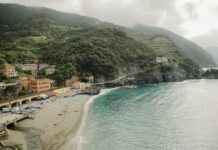The cannon should sound at 2:15 p.m. for the sailors, 131 men and seven women, spread over a single starting line several kilometers off the corsair city.
A great first in the history of the famous race, the start, originally scheduled for Sunday, was postponed due to disastrous weather conditions at the start of the week.
But on the pontoons of Saint-Malo, there is nothing to discourage the skippers who nevertheless expect fewer fans than usual, along the coast of Brittany, to come and watch the spectacle of the boats heading for the Caribbean.
«In the life of a sailor, these are exceptional, unique moments. There are all the ingredients for a great race, for it to be difficult and for you to experience a great moment of sport», enthuses Francois Gabart (SVR Lazartigue).
– «Not quiet» –
And if the weather looks better, «we must not believe that it will be quiet,» said British sailor Samantha Davies (Initiatives-Coeur). «There will always be 138 boats to tack and cross along the coast, with fishermen, traps… We will have to be very careful,» she warns.
Especially since, on the water, all sailboats do not start out equal. The fleet, a mixture of professionals and amateurs, is made up of six categories of boats: from the small monohulls that took part in the first edition, to the latest generation flying multihulls.
It is the latter, the Ultim, giant trimarans reaching more than 90 km/h on the water, which will be the first to escape to sea. Helmed by the best skippers on the planet, these giants of the seas can hope to make the crossing in six days, when the slowest sailboats will take almost a month to reach Pointe-à-Pitre.
Among the favourites, François Gabart, 39, returns to solo racing aboard a controversial Ultim launched last year.
Two other latest generation boats, designed to take off above the water thanks to foils, seem able to compete: the Maxi Edmond de Rothschild, helmed by Charles Caudrelier, and the Maxi Banque Populaire XI of Armel Le Cléac h.
– «Sprint on the Atlantic» –
In 2018, baptism of fire for these flying sailboats, the class had experienced a lot of damage. But since then, «we have worked a lot on safety, reliability (…) we have all progressed and we are going faster», promises Le Cléac’h, who capsized after two days of racing in 2018 and was rescued by a fishing boat.
After four years of development, these F1 of the seas can claim to set a new crossing record, held since 2018 by veteran Francis Joyon (7 days 14 hours 21 minutes), also at the start this year with his trimaran Idec Sport.
«It will be fast to go to Guadeloupe, the sprint on the Atlantic announced should be there», predicts Le Cléac’h. And behind the Ultims, 38 sailboats from the Imoca fleet, the monohulls (18 m) of the Vendée Globe, the famous solo round the world race, display great ambitions.
Charlie Dalin (Apivia) and Thomas Ruyant (LinkedOut), aboard the most proven boats, can hope to cross the Atlantic in 10 or 11 days, a record time.
But in this high class, several sailboats recently launched like that of Jérémie Beyou (Charal) or Yannick Bestaven (Maître CoQ) hope above all to test themselves against the autumn storms before the next «Everest des Mers», in November 2024. .















